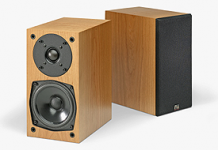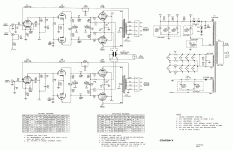Hi,
I would like to build a small valve amp just for listening to FM radio during the day, in particular BBC Radio 4 for speech and BBC Radio 3 for classical and concerts.
I think I will use my AVI Neutrons MKIV speakers
According to the website my speakers are

The Neutron IV’s comprise of a five litre, ported enclosure, fitted with a 125mm doped paper mid/woofer and a "top of the range" 25mm fabric domed tweeter. The small loss of sensitivity involved with this type of drive unit is more than offset by the greatly reduced distortion/colouration that they offer. The crossover is textbook second order and uses massive Ferrite cored inductors and polypropylene capacitors. Internal cabinet resonances are damped by a measured quantity of acoustic wadding.
Specifications:
Size H X W X D: 265 x 140 x 205mm
Bass Drive Unit: 125mm doped paper 25mm voice coil
Tweeter: 25mm doped silk composite
Crossover: 12dB/Octave Linkwitz-Riley
Sensitivity: 87.5dB/W/M
Amplitude response: +or- 2dB 100Hz to 23kHz
Bass response: -6dB @ 65Hz
Amplifier range: 30-150 Watts
Finishes: Black Ash or Cherry real wood
It would be on for a good part of the day. I am thinking of something 10-20w but you may think that would not work with the Neutron MKIV speakers.
I have a selection of Russian military spec nos tubes that I could use including
6P1P-EV
6N2P-EV
I could buy some 6P3-SE or any other suggestions.
In particular I would like to make the most of speech programmes on BBC Radio 4.
Can you recommend a suitable circuit with the diagram to build for this purpose?
I am in the uk so 230-240v ac power required
Thanks
Lee
I would like to build a small valve amp just for listening to FM radio during the day, in particular BBC Radio 4 for speech and BBC Radio 3 for classical and concerts.
I think I will use my AVI Neutrons MKIV speakers
According to the website my speakers are

The Neutron IV’s comprise of a five litre, ported enclosure, fitted with a 125mm doped paper mid/woofer and a "top of the range" 25mm fabric domed tweeter. The small loss of sensitivity involved with this type of drive unit is more than offset by the greatly reduced distortion/colouration that they offer. The crossover is textbook second order and uses massive Ferrite cored inductors and polypropylene capacitors. Internal cabinet resonances are damped by a measured quantity of acoustic wadding.
Specifications:
Size H X W X D: 265 x 140 x 205mm
Bass Drive Unit: 125mm doped paper 25mm voice coil
Tweeter: 25mm doped silk composite
Crossover: 12dB/Octave Linkwitz-Riley
Sensitivity: 87.5dB/W/M
Amplitude response: +or- 2dB 100Hz to 23kHz
Bass response: -6dB @ 65Hz
Amplifier range: 30-150 Watts
Finishes: Black Ash or Cherry real wood
It would be on for a good part of the day. I am thinking of something 10-20w but you may think that would not work with the Neutron MKIV speakers.
I have a selection of Russian military spec nos tubes that I could use including
6P1P-EV
6N2P-EV
I could buy some 6P3-SE or any other suggestions.
In particular I would like to make the most of speech programmes on BBC Radio 4.
Can you recommend a suitable circuit with the diagram to build for this purpose?
I am in the uk so 230-240v ac power required
Thanks
Lee
What does the speakers' impedance look like. Speaker manufacturers "spin" their spec's. If the nominal impedance is 8 Ω and the curve is reasonably dip free, the 87.5 dB. sensitivity can be regarded as true. OTOH, if the nominal impedance is 4 Ω and substantial dips are part of the curve, forget tubed power amplification.
The common "falsehood" is specifying sensitivity with 2.83 V. of drive. That's 1 W. when working into 8 Ω, but 2 W. working into 4 Ω. Derate the claimed sensitivity by 3 dB., in the 2nd instance.
Paul Joppa has provided us with a rule for matching amps and speakers. Joppa's Rule states that for "typical" listening spaces an amp/speaker combo should be capable of a 102 dB. SPL at a 1 M. distance. If the 97.5 dB. number is accurate, you need upwards of 32 WPC.
The 6Π3C-E (6p3s-e) in a PP configuration will get you that power. I suggest you build along the lines of the Harman-Kardon Citation V, which is a superior implementation of Mullard style circuitry. The 7581 shown in the schematic is a somewhat more powerful 6L6 family member than the Russian 5881 equivalent.
The common "falsehood" is specifying sensitivity with 2.83 V. of drive. That's 1 W. when working into 8 Ω, but 2 W. working into 4 Ω. Derate the claimed sensitivity by 3 dB., in the 2nd instance.
Paul Joppa has provided us with a rule for matching amps and speakers. Joppa's Rule states that for "typical" listening spaces an amp/speaker combo should be capable of a 102 dB. SPL at a 1 M. distance. If the 97.5 dB. number is accurate, you need upwards of 32 WPC.
The 6Π3C-E (6p3s-e) in a PP configuration will get you that power. I suggest you build along the lines of the Harman-Kardon Citation V, which is a superior implementation of Mullard style circuitry. The 7581 shown in the schematic is a somewhat more powerful 6L6 family member than the Russian 5881 equivalent.
Attachments
without undermining Eli's oft-repeated wisdom (which I buy into), remember that speech is far less demanding on the audio chain that music. The normal frequency range is narrower and the dynamic peaks are far lower (typically).
Your statement that it would be on for most of the day steers me to understanding that this is background sound with occasional periods of close listening. If you are 80% spoken word programs and 20% music, you can probably derate Eli's power requirement recommendations somewhat. How much depends on your feel for compromise.
Those speakers are likely not completely true to label as Eli points out. If you are relatively close to them for listening, its less of an issue.
Your statement that it would be on for most of the day steers me to understanding that this is background sound with occasional periods of close listening. If you are 80% spoken word programs and 20% music, you can probably derate Eli's power requirement recommendations somewhat. How much depends on your feel for compromise.
Those speakers are likely not completely true to label as Eli points out. If you are relatively close to them for listening, its less of an issue.
I recommend looking at the US Federal mandates for sound levels versus number of minutes and hours at those sound levels.
Failure to stay within those mandates in your own home will neither subject you to court cases, nor to jail time.
Instead, you will soon need hearing aids, or an even more powerful amplifier.
If you need to talk to me, then talk into my left ear. The only thing I hear in the right ear is ringing.
Just an opinion from someone who knows.
Yes, transient high sound levels are one thing, high average sound levels are another.
I seem to remember a composer named Haydn, who wrote a symphony . . . Surprise!
And those 6 Hz cannons in the Telarc recording of the Russian 1812 Overture.
Failure to stay within those mandates in your own home will neither subject you to court cases, nor to jail time.
Instead, you will soon need hearing aids, or an even more powerful amplifier.
If you need to talk to me, then talk into my left ear. The only thing I hear in the right ear is ringing.
Just an opinion from someone who knows.
Yes, transient high sound levels are one thing, high average sound levels are another.
I seem to remember a composer named Haydn, who wrote a symphony . . . Surprise!
And those 6 Hz cannons in the Telarc recording of the Russian 1812 Overture.
Last edited:
I often find it helpful when I change to a different speaker or a different amplifier,
to do a little test.
I get my oscilloscope and probe out, and take a look at the amplifier output.
But first, put on a dynamic piece, turn the volume to where you want it, and then connect the scope probe. Set the scope display to Infinite persistance (you can also see the live signal contained in there too).
Go through the whole CD.
Then take a look at the peak voltages.
You may be surprised at what you find.
How much power do you need?
At least try this test.
If you have a solid state amplifier, run the above test.
You will have a fairly good idea of how much power you need in a tube amp.
Not perfect, but it is a start.
to do a little test.
I get my oscilloscope and probe out, and take a look at the amplifier output.
But first, put on a dynamic piece, turn the volume to where you want it, and then connect the scope probe. Set the scope display to Infinite persistance (you can also see the live signal contained in there too).
Go through the whole CD.
Then take a look at the peak voltages.
You may be surprised at what you find.
How much power do you need?
At least try this test.
If you have a solid state amplifier, run the above test.
You will have a fairly good idea of how much power you need in a tube amp.
Not perfect, but it is a start.
- Status
- This old topic is closed. If you want to reopen this topic, contact a moderator using the "Report Post" button.
- Home
- Amplifiers
- Tubes / Valves
- Suggested valve amp project for FM
